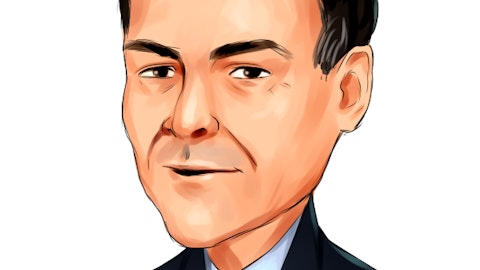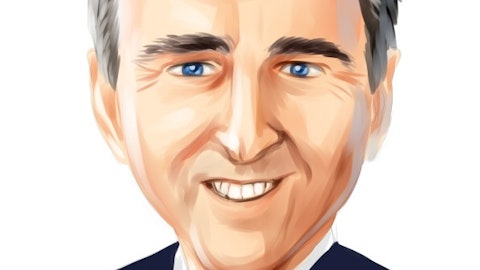Jeffrey B. Straubel: We are doing lot more country testing before launching in new markets to make sure it’s an outstanding customer experience, we’ve had in China and doing it in other countries too.
Elon Musk: Yes, exactly. It’s aaa…I was mentioning it earlier, but there…there was a bit of unhappiness in China about some of the mid-size cities, delay in customers deliveries, but where we found is that it’s more important that aaa…we can service the cars really well, that charging is sorted out amm…and to make sure that when customer do get their car, they have an excellent experience. Amm, and I think…yeah, we didn’t do as good of job as we should have done in…in some of our prime market launches and wanna make sure we recognize that mistake and correct it going forward.
Jeffrey B. Straubel: And I want to make sure I mentioned Model X cars are also obviously driving the increased R and D expenses as we are looking at Model X.
Elon Musk: Model X is like the biggest driver for R and D expense honestly. Amm, with the X aaa…we’re really trying to make an amazing car and very importantly to have a car that yet…that where the production version is better than the prototype, better than the show car. The one thing that drives me crazy about the car industry is like you will see up in these great show cars. And then when you actually get the production car it’s some, you know bizarre dumbed-down facsimile of…of the exciting prototype that was displayed, aaa…that’s terrible.
Amm, so the base line expectation of Tesla is that whenever we have a prototype, the production car is better amm…in everyway, aaa…so that’s amm…that’s…that’s quite…quite difficult to do, aaa…and requires some creative problem solving amm…and with Model X the biggest challenges is the buckling door making sure that there is truly amm…a step change in utility for the car and not a gimmick. Amm, so it’s got to work perfectly aaa…and…and the details have to be just right, amm….and that’s…it’s amazing how… like amm…sitting at little things become quite significant engineering challenges.
Such as for example getting the seals on the buckling door to aaa….work properly amm…and not be too prominent. Aaa, so that you got seal against rain, winds knot and…and against road noise, aaa…and…but you’ve got aaa…something that’s articulating across multiple hinges. You’ve got amm…aaa key…key junction joints and that kind of thing. So it’s quite a difficult ceiling problem to…to really get it right and be consistent and remain good over many years. So…so a lot of time on seal, you know engineering.
Andrea Susan James – Dougherty & Co. LLC: Thank you for the thorough response. And one more and then I’m done. Amm, why haven’t your gigafactory partner or partners, amm…why haven’t they signed on the dotted line yet?
Elon Musk: Aaa…aaa…that’s actually that’s great to be asked that question. So we actually do have aaa…aaa…a letter of intent signed with…with Panasonic. Amm, so we’re happy to announce that…that – yeah, we have a letter of intent signed. Amm, I mean, for us that’s actually not that big of a deal, because our expectation has always been that Panasonic would be the partner with the gigafactory. Amm, I believe that’s been Panasonic’s intent. Amm, and in fact just…just make sure we’re both on the same page. Aaa, J.B. aaa…aaa…spoke with Panasonic yesterday just to make sure we’re on exactly the same page. So J. B. do you want to us to elaborate on that?
Jeffrey B. Straubel: Amm, sure. Well, you know…aaa…aaa…as Elon said we do have a signed letter of intent, and under that letter of intent, aaa…we’ve also, you know, created a joint working team aaa…between Panasonic and Tesla. You know that’s…that’s working, you know almost daily, certainly weekly exploring aaa…you know, all the mutual topics and…and answering questions and making progress. Amm, you know we’re…we’re actually quite comfortable that we’re heading, you know, toward aaa…final agreements aaa…in the later part of this year. And it’s aaa…it’s something where, you know, as we said, it doesn’t seem like a big step change. It’s something that’s been, you know, aaa…progressing, you know, smoothly for the…the last months and…and we feel confident in it.
Elon Musk: Yeah. Aaa…yeah…aaa…I think we’re…aaa…I think we’re…I think quite confident, highly confident at this point of achieving the thirty percent aaa…reduction in costs per kilowatt hour. And maybe moving towards – I would say course of the optimistic about exceeding that number. Amm, I don’t want to make commitments, but I think we’ve got a decent chance of exceeding that number. Amm, as…as we explore the cost structure aaa…aaa…on the supply chain with Panasonic and with a number of other companies aaa…that… that make the pre-cost materials.
Amm, we’ve found that there’s really a lot of opportunity for innovation and for cost reduction, amm…and in…in fact, we’ve had a number of conversations that are really interesting with aaa…mining companies amm…talking about some of the key aaa…constituents that go into the…the sale, such as the nickel and cobalt, the aaa…lithium, although lith…lithium is sometimes thought of as a bigger thing than it really is for lithium ion cell.
It’s like using maybe a couple percent of the…the cell mass, aaa…but the biggest aaa…cost constituent is…is nickel amm…and amm…and we are…so we are in conversations with some of the…the nick…nickel mines in aaa…in…in Canada in particularly. Aaa, and we’ve been aaa…really I would say positively surprised, by the potential for aaa…cost reduction on the producing the pre-customer trails. Amm, and…and it’s kind of funny it’s like the – in talking to like the mining companies is like…like nobody ever calls them. We call them up and like hey we never get calls from companies like Tesla. It’s in other words like telling to them on the metal exchange or you know, some big aaa…stainless steel companies, because nickel is a common alloy and constituent of steel aaa…and like cutlery for example, using involves quite a bit of nickel so your knife and fork is usually amm…yeah, electroplated nickel silver. It’s usually what they do.
So aaa…it’s aaa…the…the…the mining guys were just like super happy to hear from us amm…and have, you know, quite…quite good ideas for how to optimize the…the cost of the materials or minimizing logistics and processing, and just doing a fairly…fairly sensible things. A lot of it’s actually quite obvious aaa…to create aaa…a…aaa…a supply chain that can deliver a large volume of factory products aaa…with incrementally reduced cost and actually we are also, you know, trying to do our best to ensure that in the supply of the components or the sell that aaa…our suppliers, you know, are going to…to the mine level are companies that operate in a good and fair way, aaa…and it’s like do they take reasonable care from an environmental standpoint, do they take care if people work in the mind that of kind of thing. As much as we can we want to make sure that…that…that our suppliers are…are good suppliers, you know, that’s…that’s the – yeah.





